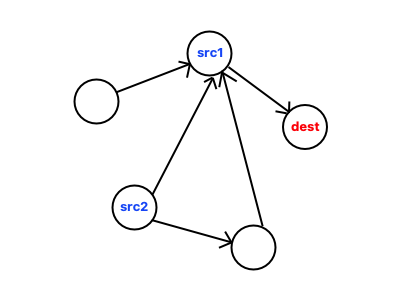[LeetCode] 2203. Minimum Weighted Subgraph With the Required Paths explained

Problem
2203. Minimum Weighted Subgraph With the Required Paths
Approach
The shortest path of target subgraph falls into 3 forms:
-
src1->src2->dest

-
src2->src1->dest

-
src1->dest,src2->dest(without sharing edges)

In every case, there always exists a vertex which two routes first join.
So we can generalize the process of finding shortest path as following:

- Find the shortest path from
src1->pivot - Find the shortest path from
src2->pivot - Find the shortest path from
pivot->dest - Add
1,2, and3.
But how do we know which vertex is a pivot?
Run dijkstra 3 times with start node src1, src2, and dest(with inversed graph for this one).
And then we simply linear search all the vertices, assuming current vertex is a pivot.
Each calculation takes \(O(1)\), thanks to precalculated shortest distances.
Note
use typelong longto avoid integer overflow.
Code

#define f first
#define s second
typedef long long ll;
typedef unsigned long long ull;
typedef pair<int,int> pii;
typedef pair<ll,ll> pll;
typedef vector<int> vi;
typedef vector<ll> vl;
typedef deque<int> di;
typedef deque<ll> dl;
typedef priority_queue<int, vi, less<int> > maxHeap;
typedef priority_queue<int, vi, greater<int> > minHeap;
class Solution {
private:
int N;
ll INF= 1e12;
vector<pii> adj[100010], adjInv[100010];
vl dijkstra(int src, bool isInv) {
vl dist(N,INF);
dist[src]= 0;
priority_queue<pll, vector<pll>, greater<pll>> pq;
pq.push({ 0, src });
while (!pq.empty()) {
ll from= pq.top().s, curDist= pq.top().f;
pq.pop();
if (curDist > dist[from]) continue;
for (pii &edge : (isInv ? adjInv[from] : adj[from])) {
ll to= edge.f, cost= dist[from]+edge.s;
if (cost < dist[to]) {
dist[to]= cost;
pq.push({ cost, to });
}
}
}
return dist;
}
public:
ll minimumWeight(int n, vector<vi> &edges, int src1, int src2, int dest) {
N= n;
for (int i=0; i < n; ++i) {
adj[i].clear();
adjInv[i].clear();
}
for (auto &edge : edges) {
adj[edge[0]].push_back({ edge[1], edge[2] });
adjInv[edge[1]].push_back({ edge[0], edge[2] });
}
vl d1= dijkstra(src1, false);
vl d2= dijkstra(src2, false);
vl d3= dijkstra(dest, true);
ll ret= +INF;
for (int i=0; i < n; ++i) {
ret= min(ret, d1[i]+d2[i]+d3[i]);
}
return ret == INF ? -1 : ret;
}
};
Complexity
- Time: \(O(n + \vert{E}\vert\log{n})\)
- Space: \(O(n)\)

Leave a comment